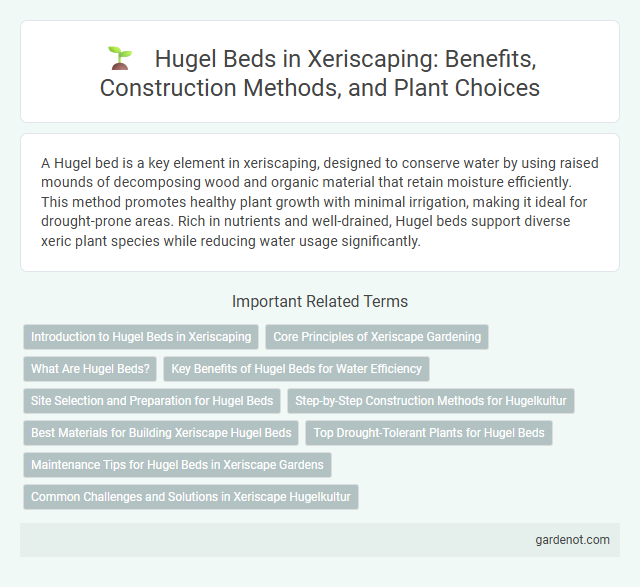A Hugel bed is a key element in xeriscaping, designed to conserve water by using raised mounds of decomposing wood and organic material that retain moisture efficiently. This method promotes healthy plant growth with minimal irrigation, making it ideal for drought-prone areas. Rich in nutrients and well-drained, Hugel beds support diverse xeric plant species while reducing water usage significantly.
Introduction to Hugel Beds in Xeriscaping
Hugel beds are a key technique in xeriscaping that involve creating raised garden beds using decaying wood and organic matter to improve water retention and soil fertility. This method mimics natural forest processes, promoting efficient moisture use and reducing irrigation needs in drought-prone landscapes. Incorporating Hugel beds enhances plant growth while conserving water, making them ideal for sustainable xeriscaping designs.
Core Principles of Xeriscape Gardening
A Hugel bed exemplifies xeriscape gardening by maximizing water retention through layered organic matter and soil, reducing the need for irrigation. This method promotes efficient water use by enhancing soil moisture and encouraging deep root growth, aligning with xeriscape's core principles of water conservation and sustainable landscaping. Integrating Hugel beds supports native plant health and soil fertility, minimizing water waste while maintaining ecological balance.
What Are Hugel Beds?
Hugel beds are raised garden beds constructed by layering wood, branches, leaves, and soil to create a nutrient-rich, moisture-retentive growing environment. This permaculture technique enhances water retention and soil fertility, making it ideal for xeriscaping and drought-resistant gardening. Hugel beds support diverse plant growth by mimicking natural forest decomposition processes.
Key Benefits of Hugel Beds for Water Efficiency
Hugel beds significantly enhance water efficiency by retaining moisture through decomposing organic matter inside the mound, reducing the need for frequent irrigation. Their layered structure improves soil aeration and nutrient availability, promoting deep root growth and minimizing water runoff. This sustainable gardening method aligns perfectly with xeriscape principles, conserving water while supporting healthy plant development in arid environments.
Site Selection and Preparation for Hugel Beds
Choosing a well-drained, sunny location is crucial for optimal hugel bed performance, as these beds thrive with adequate sunlight and air circulation. Site preparation involves clearing debris, leveling the ground, and ensuring access to water sources to support plant establishment. Incorporating organic waste, logs, and woody materials during bed construction enhances moisture retention and soil fertility, promoting sustainable xeriscape gardening.
Step-by-Step Construction Methods for Hugelkultur
Hugelkultur construction begins with selecting a suitable location and digging a shallow trench to improve drainage. Next, layer logs, branches, and twigs at the bottom, ensuring air pockets for decomposition to enrich the soil over time. Cover this woody base with compost, topsoil, and mulch, shaping the bed into a mound that retains moisture and supports drought-resistant xeriscape plants effectively.
Best Materials for Building Xeriscape Hugel Beds
Ideal materials for building xeriscape hugel beds include locally sourced hardwood logs, as they decompose slowly, providing long-term moisture retention and soil enrichment. Branches, twigs, and dried leaves create aeration and organic matter that supports microbial activity essential for dryland gardening. Incorporating well-aged compost ensures nutrient availability while minimizing water usage, enhancing plant resilience in arid environments.
Top Drought-Tolerant Plants for Hugel Beds
Hugel beds thrive with drought-tolerant plants such as lavender, rosemary, and sedum, which require minimal water and enhance soil moisture retention. Succulents like agave and aloe vera excel in xeriscaping practices by storing water in their leaves, making them ideal for hugelkultur gardens. Incorporating native grasses and herbs like yarrow and thyme further promotes resilience and sustainability in arid climates.
Maintenance Tips for Hugel Beds in Xeriscape Gardens
Hugel beds in xeriscape gardens require minimal watering due to their water-retentive wood core, but occasional monitoring of soil moisture ensures optimal plant health. Regularly removing mulch and debris prevents fungal growth and maintains aeration around roots. Periodic pruning of plants and replenishing decomposed wood layers sustains nutrient flow and structural integrity.
Common Challenges and Solutions in Xeriscape Hugelkultur
Hugelkultur beds in xeriscaping often face challenges such as initial soil nitrogen depletion and uneven moisture retention due to decomposing wood. To counteract nitrogen immobilization, incorporating nitrogen-rich compost and green mulch around the woody material enhances soil fertility. Proper layering of absorbent organic matter and mulching with drought-tolerant groundcovers optimizes water retention, ensuring consistent moisture availability for xeriscape plants.
Hugel bed Infographic

 gardenot.com
gardenot.com